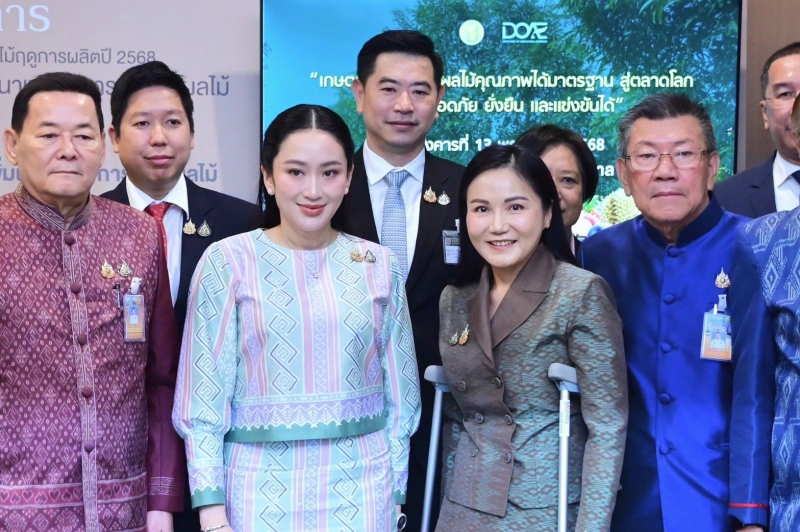
Assoc. Prof. Dr. Narumon Pinyosinwat, Minister of Agriculture and Cooperatives, revealed after organizing the Prime Minister's meeting with fruit purchasing entrepreneurs to help fruit farmers at Building 1, Government House that during the fruit season of 2025, the Ministry of Agriculture and Cooperatives, through the Department of Agricultural Extension, has strictly controlled product quality to be up to standard and safe. This is done through the Fruit Development and Management Committee (Fruit Board), which has managed the fruits of the 2025 production season to upgrade Thai farmers to produce quality fruits that meet standards for the international market through 3 measures:
Measure 1: Promote the increase in fruit production productivity by improving quality, mitigating and adapting to climate change, promoting orchard-level production according to GAP measures, and managing weather, nutrients, water, diseases, and pests.
Measure 2: Monitor, prevent, control, and supervise plant health and safety standards throughout the production chain, from the production plot, the packing house, to the export process. Distribute products by managing to extend the period of fruit to the market, so that the market is not concentrated, and there is more accurate data for planning, which helps manage the market better. Measure 3: Increase the efficiency of the fruit market mechanism, emphasizing integrated work by the Fruit Development and Management Committee, in cooperation with all sectors, both government, private, and farmer partners, under 7 measures and 25 plans, which emphasize that all parties must work closely together to strictly maintain the standards and upgrade Thai agricultural products. In the past, there was a plan to monitor and manage risks in fruit management operations in 2025 during May - June, when products are about to be released to the market, including preparing water management, controlling products to meet standards, preventing fraud, increasing the efficiency of certification laboratories, intensive random fruit quality testing, promoting knowledge for farmers to prepare for drought and summer storms (Climate Change), and publicizing domestic fruit consumption, as well as facilitating cross-border and cross-border trade, etc.
In addition, the Ministry of Agriculture and Cooperatives has implemented 5 approaches: Approach 1: Product management by planning product distribution, using data in management, extending the period of fruit bearing, preventing the market from being concentrated, resulting in products in the eastern and southern regions not being concentrated; Approach 2: Quality control from the plantation, raising GAP standards for durian, setting up inspection points before cutting, preventing unripe durian from entering the market; Approach 3: Farmer group management, increasing the role of large-scale plantations and cooperatives in controlling the quantity and quality of products; Approach 4: Adding value to agricultural products, grading fruits, for products that are substandard, processing them into high-value agricultural products such as freeze-drying or extracting them for pharmaceutical purposes; Approach 5: Increasing marketing channels, promoting e-Commerce channels for farmers.
Mr. Peerapan Kothong, Director-General of the Department of Agricultural Extension and Secretary of the Fruit Development and Management Committee, added that the production situation of 4 types of fruits, namely longan, mango, durian and mangosteen in the North, East and South in 2025, amounting to 3.4 million tons, increased from 2024, which had a volume of 2.78 million tons or increased by 22%.
Longan in the North in 2025 is expected to have a volume of 1.64 million tons and longan in the East is expected to have a production volume of 210,000 tons and the highest production will be released to the market at 60% in August to September.
Mangoes in the North in 2025 are expected to have a volume of 108,000 tons, with the highest production reaching 50% in April to May. As for mangoes in the East, the production volume is expected to be 33,000 tons, with the highest production reaching 60% in May.
Durian in the Eastern region in 2025 is expected to have a volume of 871,000 tons, with the highest production reaching the market at 55% in May to June. Durian in the Southern region is expected to have a volume of 700,000 tons, with the highest production reaching the market at 70% in July to August.
Mangosteen in the East in 2025 is expected to have a volume of 258,000 tons, with the highest production reaching the market of 70% in May to June. Mangosteen in the South is expected to have a volume of 147,000 tons, with the highest production reaching the market of 50% in August. The production volume of all 4 types of fruit trees this year has increased because last year, it was affected by the El Niño phenomenon and volatile weather. The production volume was low, so the trees were allowed to rest and store food. The trees were in good condition and ready to flower and bear fruit fully. In addition, this year, the weather is cold, which is conducive to flowering and fruiting. The average production per rai has increased for all 4 types. In addition, durian that has been planted in the past several years has started to produce for the first time, increasing by 72,908 rai, or an increase of 14.69 percent.
Ref: Ministry of Agriculture and Cooperatives Thailand
Your email address will not be published. Required fields are marked *